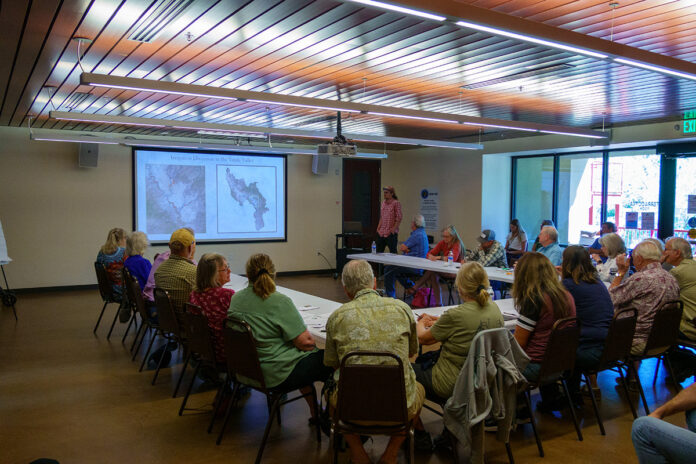The Verde Natural Resource Conservation District held a local work group meeting at the Camp Verde Community Library on May 12 to discuss the community’s resource concerns and help determine the NRCD’s long-term goals in order to inform funding recommendations for future projects.
The meeting gathered community members to determine which issues were important to them, such as irrigation efficiency and preserving rural space.
John Ford from The Nature Conservancy gave a presentation on irrigation efficiencies in the Verde Valley and the best practices for surface water use. Ford pointed out that only 2% of the Verde Valley consists of riparian areas, but those areas are critical to 80% of wildlife.
There are about 40 irrigation ditches in the Verde Valley, most of which are small, that divert surface water from the river. Ford argued that ditch irrigation management was difficult and emphasized the importance of smart agriculture.
Ford’s presentation also broke down a variety of methods by which greater efficiency can be obtained in the diversion, conveyance and on-farm stages of water use. Diversion efficiency involves using automated headgates to increase water control and to allow recreational and fish passage at diversions.
Conveyance efficiency involves repairing piping to bring in water faster with less loss. On-farm efficiency involves using more efficient irrigation techniques, such as drip irrigation. The least efficient irrigation method is wild flood irrigation, which is 30% to 50% efficient, while surface drip irrigation is 75% to 90% efficient and subsurface drip is 85% to 95% efficient.
The Nature Conservancy is looking to implement a soil moisture meter program to enable residents to assess how much water they actually need in order to be productive.
Matt Halverson, director of the Yavapai County Cooperative Extension of the University of Arizona, discussed available farm programs in which residents can participate. The extension’s farmer apprentice program matches farmers with apprentices and pays farmers $10,000 a year to host and mentor an apprentice. Halverson noted that many people want to start a career in agriculture but have no background in the subject.
The water efficiency improvement program provides up to $1,500 per acre if a grower can show a 20% efficiency gain by switching to a method more efficient than flood irrigation, such as sprinkler, drip or pivot.
Sierra Frydenlund, a soil conservationist with the Natural Resource Conservation Service, spoke on NRCS projects to provide financial and technical assistance to farmers, such as soil surveys and water conservation plans, and shared work she had done calculating snow melt from snow pack depth.
Carter Benton from the Salt River Project offered updates on water adjudication in the Verde Valley; the Verde Valley falls under the Gila River adjudication, which has 87,000 individual claims. Groundwater withdrawals continue to be an issue, Benton claimed, along with a lack of data and a lack of regulation.
Erin Cody, director of the environmental education center of the Verde NRCD, gave attendees a demonstration of the permeability of various soils. After showing that gravel allows water to pass through it easily while sand slows the flow and sandy clay loam, common in the area, blocks it altogether, Cody pointed out that the lack of porosity in the clay loam is behind much of the flooding in the Verde Valley.
She also noted that its lack of absorption means that flood irrigation keeps more water on the surface, allowing evaporation and increasing inefficiency. The lack of porosity in the clay loam also enables greater erosion by reducing absorption, as Cody demonstrated using a rainfall simulator. Amended sandy clay loam, with an inch of mulch on top, experienced significantly less runoff and increased the amount of water percolating into the ground.



